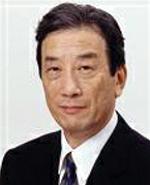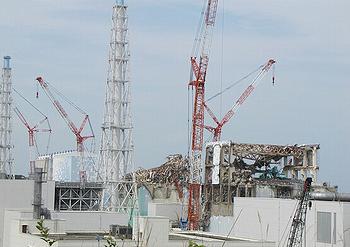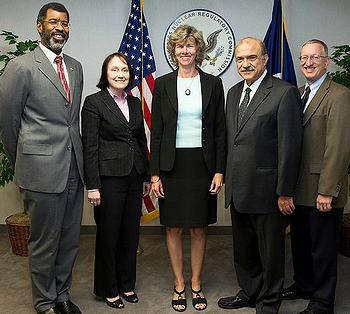Groups: U.S. Shares 'Mindset' Behind Japan's Nuclear Disaster
WASHINGTON, DC, July 12, 2012 (ENS) - The same "man-made" problems underlying last year's nuclear disaster in Japan exist today in the United States, warn five U.S. groups responding to the Fukushima Nuclear Accident Independent Investigation Commission's report to Japan's Diet, or parliament.
The Commission found that the accident at Tokyo Electric Power Co.'s Fukushima Daiichi nuclear power plant, "...was the result of collusion between the government, the regulators and TEPCO, and the lack of governance by said parties. They effectively betrayed the nation's right to be safe from nuclear accidents. Therefore, we conclude that the accident was clearly 'man-made.'"
 |
Dr. Kiyoshi Kurokawa (Photo courtesy WHO) |
Commission Chairman Kiyoshi Kurokawa, M.D., science advisor to the Cabinet of Japan, wrote that although the March 11, 2011 disaster was triggered by "cataclysmic" natural events - a magnitude 9.0 earthquake and resulting tsunami - the accident "cannot be regarded as a natural disaster."
"It was a profoundly man-made disaster - that could and should have been foreseen and prevented," he wrote. "And its effects could have been mitigated by a more effective human response."
"Our report catalogues a multitude of errors and willful negligence that left the Fukushima plant unprepared for the events of March 11. And it examines serious deficiencies in the response to the accident by TEPCO, regulators and the government," wrote Dr. Kurokawa in his introduction to the executive summary of the Commission's report, released July 5.
Yet, he wrote, it is the "mindset" of Japanese society that is really the cause of the disaster.
"For all the extensive detail it provides, what this report cannot fully convey - especially to a global audience - is the mindset that supported the negligence behind this disaster," he wrote. "What must be admitted - very painfully - is that this was a disaster 'Made in Japan.' Its fundamental causes are to be found in the ingrained conventions of Japanese culture: our reflexive obedience; our reluctance to question authority; our devotion to 'sticking with the program'; our groupism; and our insularity."
 |
Smoke rises from Unit 3 of the stricken Fukushima Daiichi nuclear power plant after a hydrogen explosion, March 21, 2011. (Photo courtesy TEPCO) |
"Only by grasping this mindset can one understand how Japan's nuclear industry managed to avoid absorbing the critical lessons learned from Three Mile Island and Chernobyl; and how it became accepted practice to resist regulatory pressure and cover up small-scale accidents," Dr. Kurokawa wrote. "It was this mindset that led to the disaster at the Fukushima Daiichi Nuclear Plant."
Back in the United States, the five groups today warned that just as Japan did not learn the lessons of nuclear accidents at Three Mile Island and Chernobyl, U.S. regulators and the nuclear industry are failing to learn the lessons of Fukushima.
"The report concluded that regulation in Japan was not rigorous. Sadly that applies to the United States as well," said Dr. Arjun Makhijani, president of the Maryland-based Institute for Energy and Environmental Research.
"Just 10 days after the start of the Fukushima disaster, the NRC [Nuclear Regulatory Commission] extended the license of Vermont Yankee for 20 years, though it is the same design as the Fukushima reactors and it has more spent fuel in its pool than all four stricken reactors there put together," Makhijani said. "The report should jolt the NRC into implementing the lessons of Fukushima before licensing new reactors and relicensing existing ones."
Another U.S. nuclear watchdog, Bobbie Paul, who serves as executive director with Georgia Womens' Action for New Directions, said, "It is tragic that this report was not published before Southern Company's reactors 3 and 4 in Burke County, Georgia were given the green light by the NRC."
Paul recalled the lone dissenting voice of then NRC Chairman Gregory Jaczko, who said, "I cannot support issuing this license as if Fukushima had never happened."
"This report validates the NRC chairman and should cause every citizen to challenge claims made by the nuclear industry that it can never happen here," said Paul. "Man-made disasters - whether made in Japan or made in the USA - can and do happen."
The disaster started March 11, 2011 when the earthquake and tsunami knocked out power to the Fukushima Daiichi nuclear power plant on Japan's Pacific coast, disabling the fuel cooling systems and their emergency backups. This resulted in a series of hydrogen explosions, nuclear fuel meltdowns, and the release of radiation into the air, on land and at sea.
 |
Work to decommission Fukushima Daiichi is underway, May 26, 2012 (Photo by SimplyInfo) |
The accident is rated at Level 7, the highest on the UN's International Nuclear Event Scale, and is considered the world's second most serious nuclear disaster, after Chernobyl.
After more than 900 hours of hearings, interviews with 1,167 people, and nine site visits to nuclear power plants including Fukushima Daiichi, the Commission concluded, "There was a distinct potential at the time for this disastrous accident to result in an even more frightening scenario."
As to why the response was inadequate, the Commission said, "...there were organizational problems within TEPCO. Had there been a higher level of knowledge, training, and equipment inspection related to severe accidents, and had there been specific instructions given to the on-site workers concerning the state of emergency within the necessary time frame, a more effective accident response would have been possible."
Approximately 150,000 people were evacuated from a 30 kilometer (20 mile) radius around the Fukushima power plant in response to the accident. An estimated 167 workers were exposed to more than 100 millisieverts of radiation while dealing with the accident.
As much as 1,800 square kilometers (695 square miles) of land in Fukushima Prefecture has now been contaminated by a cumulative radiation dose of five millisieverts or higher per year.
"The Commission recognizes that the residents in the affected area are still struggling from the effects of the accident," the report states. "They continue to face grave concerns, including the health effects of radiation exposure, displacement, the dissolution of families, disruption of their lives and lifestyles and the contamination of vast areas of the environment. There is no foreseeable end to the decontamination and restoration activities that are essential for rebuilding communities."
"The Commission concludes that the government and the regulators are not fully committed to protecting public health and safety; that they have not acted to protect the health of the residents and to restore their welfare."
 |
FirstEnergy's Davis-Besse nuclear power station near Toledo, Ohio has been plagued with technical problems for 10 years. (Photo by Franklin Gray) |
In the United States, Michael Mariotte, executive director of Maryland-based Nuclear Information and Resource Service, NIRS, said, "Unfortunately, the U.S. reality is no different: a powerful nuclear power industry consistently gets its way at a weak and accommodating Nuclear Regulatory Commission. And thus, another nuclear accident also becomes inevitable."
"One area where Japan flunked the test was emergency evacuation. In a move to incorporate the lessons of Fukushima," said Mariotte, "NIRS has proposed strengthening emergency planning regulations and expanding emergency planning zones. But the industry wants less, not better emergency planning."
The Fukushima Nuclear Accident Independent Investigation Commission was established by law in October 2011. The Commission's 10 members were appointed in December by a joint committee of both Houses of the Diet.
"This report is meant to reinforce the administrative authority of the legislative body and strengthen oversight activities on issues related to nuclear power," Dr. Kurokawa wrote. "As the first independent commission chartered by the Diet in the history of Japan's constitutional government, we would like to emphasize how important it is that this report be utilized, for the Japanese people and for the people of the world."
"American regulators and the federal government should take heed," said Physicians for Social Responsibility Executive Director Catherine Thomasson. "This report should serve as a warning that the U.S. has the same colluding system between industry, regulators and government."
Dr. Stephen Smith, executive director of Southern Alliance for Clean Energy, called the Japanese commission's report "extremely important" in the Southeast given the high percentage of existing and proposed nuclear reactors in the region.
 |
Current U.S. Nuclear Regulatory Commission, from left: William Magwood, Kristine Svinicki, Chair Allison Macfarlane, George Apostolakis and William Ostendorff, July 9, 2012 (Photo courtesy NRC) |
"Since Fukushima, we've listened to industry proponents and nuclear utilities constantly telling the public that a tsunami can't happen here or an earthquake of the scale of Fukushima," said Smith. "But this report is saying that the devastating Fukushima accident was 'man-made.' That a 'witch's brew' of regulator, utility and government negligence led to this tragedy. Unfortunately, that collusion and lack of oversight occurs right here."
The U.S. nuclear industry organization, the Nuclear Energy Institute, defends the safety of its reactors, arguing that the U.S. industry and government regulators already are taking many actions to prevent a Fukushima-type accident.
"Within one week of the Fukushima accident, operators at the 104 U.S. reactors were reviewing systems and components to ensure that the designed features and measures could mitigate the effects of a seismic event, flood or complete loss of AC power," the NEI states in a White Paper issued earlier this month.
"The U.S. nuclear industry has pooled resources to ensure the lessons from Japan are systematically gathered, analyzed and implemented. This process has already identified near-term enhancements that will add further to the margin of safety," writes the NEI.
On March 12, the U.S. Nuclear Regulatory Commission issued three orders requiring safety enhancements by reactor operators, construction permit holders, and combined license holders that must begin immediately and be completed within two refueling outages or by December 31, 2016, whichever comes first.
The NRC orders require strategies to respond to extreme natural events resulting in the loss of power, enhanced instrumentation in spent nuclear fuel pools, and reliable hardened containment vents.
NRC spokesman Scott Burnell explains on his blog that "The idea of 'containment venting' has been front and center in discussions about the Fukushima Daiichi nuclear accident and what the NRC wants [U.S.] plants to do to improve their vents."
The vents can safely release built-up hydrogen to prevent explosions and so they must be able to withstand possible fires and small explosions. "The vents must be reliable enough to be operated even if the reactor loses all electrical power or if other hazardous conditions exist," blogged Burnell in April. "The NRC staff will issue, later this summer, specific guidance on the requirements for containment vents."
For handling the loss of all electrical power, or "station blackout," as occurred at Fukushima Daiichi, the NRC has proposed a formal change to its regulations on March 20. The public comment period ended May 4, and the NRC is evaluating the comments it received and preparing to publish a proposed rule.
At the Fukushima Daiichi plant today, Tokyo Electric Power is working towards decommissioning the damaged facility.
Crews are preparing to start test runs for removing highly radioactive nuclear fuel rods from the storage pool of the Unit 4 reactor after Japan's nuclear regulator approved safety measures for the removal procedure.
Concerns have been raised about the state of the ruined reactor building and the fuel pool, which contains 1,535 fuel rods, the highest number at the plant. The test involves removing just two rods from the pool. TEPCO declines to reveal the date of the test for security reasons but says removal of all the rods is scheduled to begin sometime next year.
Copyright Environment News Service (ENS) 2012. All rights reserved.